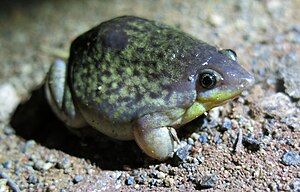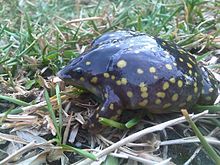Hemisus
| Hemisus | ||||||||||||
|---|---|---|---|---|---|---|---|---|---|---|---|---|

|
||||||||||||
| Systematics | ||||||||||||
|
||||||||||||
| Scientific name of the family | ||||||||||||
| Hemisotidae | ||||||||||||
| Cope , 1867 | ||||||||||||
| Scientific name of the genus | ||||||||||||
| Hemisus | ||||||||||||
| Günther , 1859 |
Hemisus is the only genus of the amphibian family Hemisotidae . In German they are sometimes referred to as shovel-nosed frogs.
description
The pupils are vertical. The tongue is wide, elongated, incised at the back and freely liftable. Palate teeth , eustachian tube and ear drum are missing. The tips of the fingers and toes are pointed with simple bony terminal phalanges. The fingers are free. On the toes there is at most a very weak web of webs which does not intervene between the metatarsi of the 4th and 5th toes. The precoracoids are strongly developed and transverse. The coracoid are long and narrow and form an acute angle with their medial, not widened ends. The omosternum is cartilaginous, the sternum withered. The transverse processes of the sacral vertebra are slightly widened.
The species Hemisus marmoratus (presumably also the other species of the genus that have not yet been investigated) has an unusual mechanism for lengthening the tongue; As with many frogs, this is essentially involved in catching prey. In most frogs, the tongue is pulled forward by muscles and then flicked forward due to inertia. In the case of Hemisus marmoratus , the tongue is compressed by a muscle acting dorsoventrally (from top to bottom). It has the properties of a liquid-filled cushion with constant volume and is thereby extended hydrostatically .
Occurrence
The genus occurs in tropical and subtropical Africa south of the Sahara.
Way of life
The species of the genus are known for the fact that the females dig underground breeding chambers in the soil next to bodies of water. Unlike 95 percent of the burrowing frogs, they do not dig with their hind legs, but with their fore extremities. The developed tadpoles leave these via a tunnel dug by the female to the water. In a study on Hemisus marmoratus in Ivory Coast, the breeding chambers were about 5 centimeters in size and contained about 200 (between 88 and 242) eggs. Some of them were located on the banks of the river, but some were up to 100 meters away from existing bodies of water, mostly under fallen trees. The female remains in the brood chamber and tries to defend eggs and tadpoles from disturbance. The tadpoles usually leave the breeding chamber after the start of the rainy season, when temporary ponds and streams lead again. According to research, the species is a food specialist ( termites ) and lives both in the open savannah and in gallery forests.
Systematics
The genus Hemisus was first described by Albert Günther in 1859 . A synonym is Kakophrynus Steindachner, 1863. It comprises 9 species:
- Hemisus barotseensis Channing & Broadley, 2002
- Hemisus brachydactylus Laurent, 1963
- Hemisus guineensis Cope, 1865
- Hemisus guttatus (Rapp, 1842)
- Hemisus marmoratus (Peters, 1854)
- Hemisus microscaphus Laurent, 1972
- Hemisus olivaceus Laurent, 1963
- Hemisus perreti Laurent, 1972
- Hemisus wittei Laurent, 1963
The sister group of the Hemisotidae is believed to be the Brevicipitidae family .
Individual evidence
- ^ Fritz Nieden: Anura II . In: FE Schulze, W. Kükenthal, K. Heider (Ed.): Das Tierreich . Walter de Gruyter & Co., Berlin and Leipzig 1926, p. 10.
- ^ KC Nishikawa, WM Kier, KK Smith (1999): Morphology and mechanics of tongue movement in the African pig-nosed frog Hemisus marmoratum: a muscular hydrostatic model. Journal of Experimental Biology 202: 771-780.
- ↑ a b Darrel R. Frost: Hemisus Günther, 1859 . In: Amphibian Species of the World: an Online Reference . Version 6.0 (accessed February 19, 2014). ( online ).
- ↑ Sharon B. Emerson (1976): Burrowing in frogs. Journal of Morphology 149: 437-458. doi : 10.1002 / jmor.1051490402
- ^ MO Rödel, M. Spieler, K. Grabow, C. Böckheler (1995): Hemisus marmoratus (Peters, 1854) (Anura: Hemisotidae), reproductive strategies of a savannah frog. Bonn Zoological Contributions 45 (3/4): 191-207.
- ^ DC Blackburn & DB Wake (2011): Class Amphibia Gray, 1825. In: Zhang, Z.-Q. (Editor) Animal biodiversity: An outline of higher-level classification and survey of taxonomic richness. Zootaxa 3148: 39-55.


